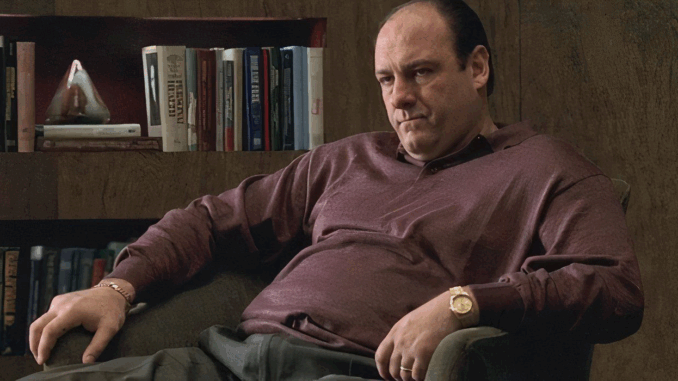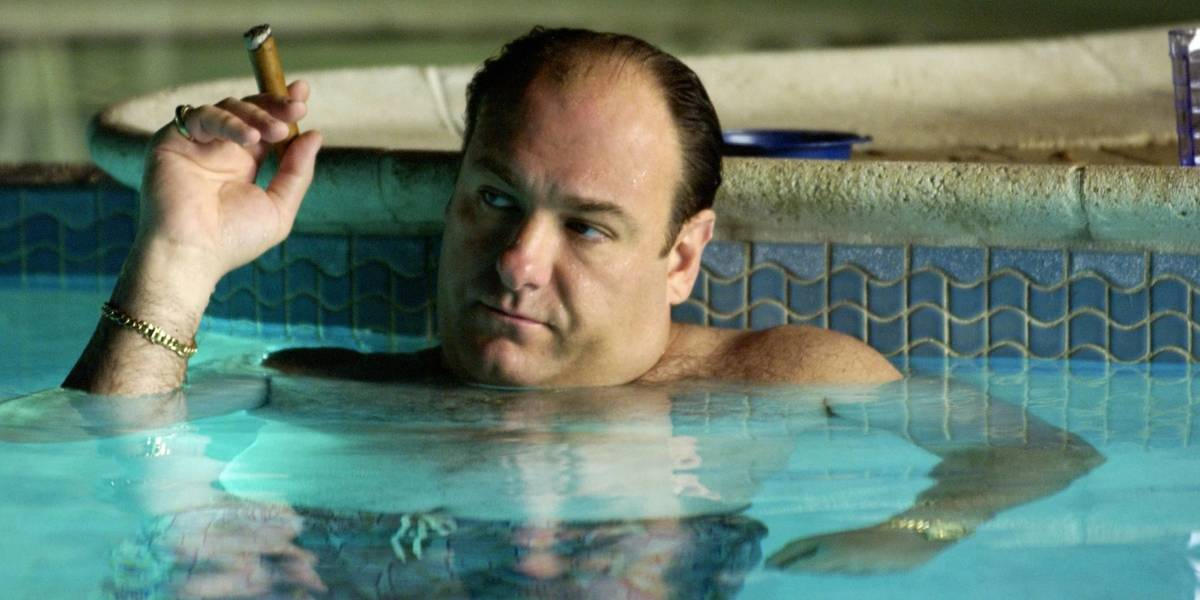
Decades after its groundbreaking run concluded as arguably the most debated and celebrated television show, fans and critics of The Sopranos continue to keep its dense mythology alive. Online forums, podcasts, and countless fan pages dissect every ambiguous glance, symbolic dream sequence and unresolved plotline. From the meaning of ducks in a swimming pool to the ultimate fate debated in Holsten’s diner, The Sopranos is a landscape rich with lore.
Yet, amidst these theories, one of the most fundamental and omnipresent pieces of The Sopranos’ iconography often hides in plain sight: the show’s instantly recognizable title logo. Specifically, the stark silhouette of a handgun seamlessly integrates into the very letters spelling out the family name. While its presence seems almost self-evident today, there’s an origin story behind that creative touch. To those who thought that the gun was only there as a genre identifier, it was all a delusion.
The Story Behind The Sopranos Logo’s Specific Design Element
According to accounts, when David Chase’s series was preparing to launch in 1999, HBO executives reportedly harbored a fear. The title, The Sopranos, with its musical connotations evoking opera and high C’s, might confuse potential viewers. Would audiences mistakenly think they were tuning into a show about classical singers rather than ruthless New Jersey mobsters? Yes, there was a high possibility of such a misunderstanding.
While speaking to Art of The Title, Brett Wickens, the creative genius behind The Sopranos logo, revealed that he was one of those confused people who judged the concept of the show by its title. He said, “I remember being handed the Sopranos script and thinking that the title referred to opera singers, which didn’t seem very interesting! So I put it on my desk, and it sat there for a few days, unopened. When I did actually read it, it was clear that the name had thrown me! It was a pretty interesting story about a mobster spending time with a shrink.”
In order to avoid such confusion and make the show’s subject matter clear, the decision was made to incorporate a visual cue that screamed “crime”, “violence”, and “mafia.” Hence, the handgun graphic replacing the ‘r’ was put in the title to serve the purpose. The Sopranos was a gritty, modern take on organized crime. Hence, from a marketing and branding perspective, the move was a masterstroke. Interestingly, Wickens shared that The Godfather logo inspired him to do something different. He said:
“I remembered the classic The Godfather poster; there was a lot of black and red, and the ‘marionette’ metaphor for the logo. I felt like the logo needed to be red against black, and it needed something quick and symbolic to steer it into the right territory.”
The logo immediately conveyed the show’s genre and tone; it was bold, slightly menacing and iconic. When paired with the image of Tony Soprano himself in promotional material, the gun logo gave a glimpse into the chaotic mind of the mafia boss. However, another interesting thing about The Sopranos logo is the way it signifies by embedding violence directly into the family name, which opens the door to further interpretations. It visually encapsulates the show’s central themes of violence irrevocably intertwined with family identity, reflects Tony’s core internal conflicts, and speaks to the inevitable nature of “this thing of ours.”
The True Brilliance of The Sopranos Logo
Beyond its practical and technical origins, the true brilliance of The Sopranos logo lies in the deliberate placement of the gun. It doesn’t merely sit beside the name; it violently replaces a letter, becoming an integral part of the word and Tony Soprano’s life. This visual fusion foreshadowed a deep psychological level, primarily centered on the show’s protagonist. For Tony, the gun added to his identity is a potent symbol of his internal conflict. It represents the bedrock of his power, authority, and the fear-fueled ‘respect’ he commands.
At the same time, the logo also captures the paradox of being Tony Sopranos. He is a mafia boss who is very proud of his possession of guns, but it’s both his crown and cross. It was the very source of the crushing anxiety, depression and panic attacks that plagued him and led him to Dr. Melfi’s office. The status, wealth and power brought upon him by this occupation is what corroded his soul, poisoning his relationships and leaving him isolated.

This symbolic weight is powerfully mirrored by the tangible presence of guns throughout The Sopranos’ narrative. The weapon isn’t just an abstract signifier in the logo; it’s a ubiquitous tool and a status symbol. The viewers see Bobby Baccalieri gift Tony an assault rifle for his birthday, a gesture loaded with meaning within their violent hierarchy. Ralph Cifaretto disastrously gives a handgun to the impressionable Jackie Jr., directly contributing to the young man’s downfall.
Tony himself, seeking a ‘safe’ space outside his home yet unable to escape the tools of his trade, resorts to stashing guns within the wall of the Green Grove retirement community where his mother resides. He places the potential of violence and danger within a space meant for elder care. Guns are sure to make these people very powerful in their world, but they are linked to their paranoia and, ultimately, self-destruction.
The Gun Represents How The American Dream Became A Nightmare for The Sopranos
And How Carmela Soprano Stands as a Corrupted Version of The Dream
The Soprano family looks like an upper-class family living in their North Caldwell McMansion, surrounded by the trappings of suburban affluence—luxury SUVs, high-end consumer goods, and a desire to send their children to Ivy League schools. From the outside, it’s a clan living the American dream by being far removed from their working-class origins. However, on the surface, the truth is beyond what it’s painted as. And the gun replacing that ‘r’ in the family name is a stark reminder that these people are living a corrupted American dream.
The gun critiques Tony Sopranos’s ‘success’ as a mafia officer, telling viewers that the empire is not built on legitimate service. The inclusion of the weapon in the logo isn’t presented as an unfortunate byproduct of their professional activities but is a silent testament to how their American dream is achieved and maintained. Tony is aware of this sentiment, and much of his internal conflict is generated from this feeling. In the pilot episode, Tony shares his existential thoughts with Dr. Melfi. During the scene brilliantly played by James Gandolfini, he says, “The morning of the day I got sick, I’d been thinking. It’s good to be in something from the ground floor. I came too late for that. I know. But lately, I’m gettin’ the feelin’ that I came in at the end. The best is over. Many Americans, I think, feel that way.”
Tony then goes on about what he was thinking about his father in this profession. “I think about my father. He never reached heights like me. But in a lot of ways, he had it better. He had his people. They had their standards. They had pride. Today, what do we got?” The show explores how the American Dream is not a fixed entity but an “ever-evolving process” shaped by cultural and demographical shifts. Much like the changing landscape of Newark that contrasts Tony’s world with that of his father, Johnny Boy.
Fans of The Sopranos are well aware of its portrayal of materialism and consumerism; hence, who else better than Carmela Soprano, played by Edie Falco, to represent the American Dream twisted and tainted by the Soprano family’s criminal enterprise? Along with bearing the consequences of Tony’s deeds, Carmela is a victim of her own choices and hypocrisy. Fully aware of the illicit origins of Tony’s income, she navigates a complex moral landscape. She knows of her husband’s infidelities, which she condemns yet tolerates, and her choices highlight the seductive power of material comfort and social aspirations.
Despite knowing that her desires are funded by “dirty money”, Carmela continues to live with the uncomfortable truth. She is the compromised pursuit of the American dream, one where the allure of suburban success and its luxury creates a moral tightrope walk, forcing her to fulfill her desire with the dark reality of their foundation. The logo from the beginning initially brands The Sopranos with the inherent contradiction and perhaps the spiritual emptiness of a dream that is achieved with blood. While including a gun in the title served as a pragmatic solution to HBO’s worries, its significance runs far deeper.
